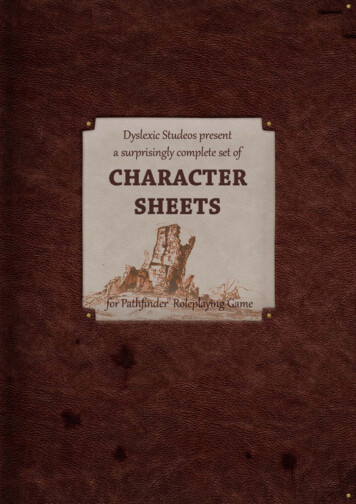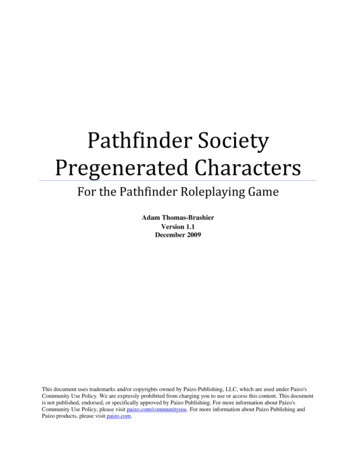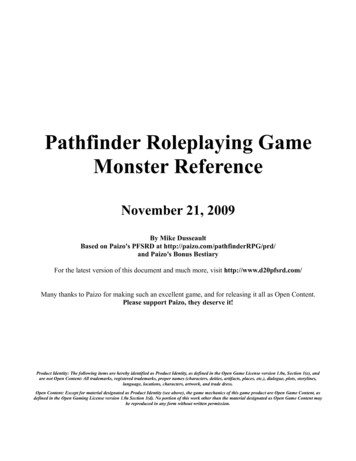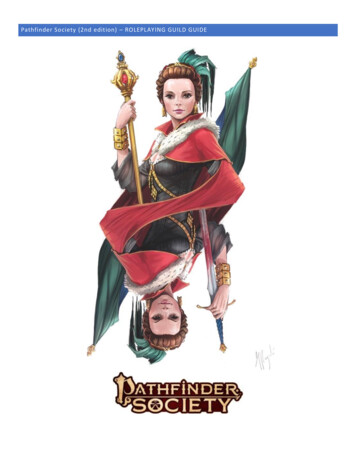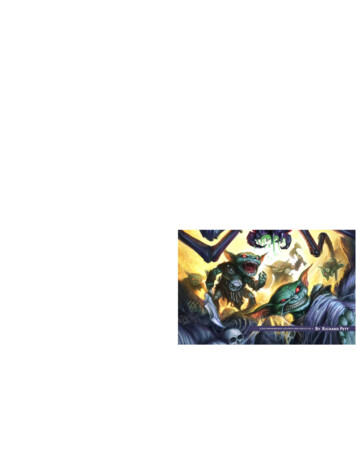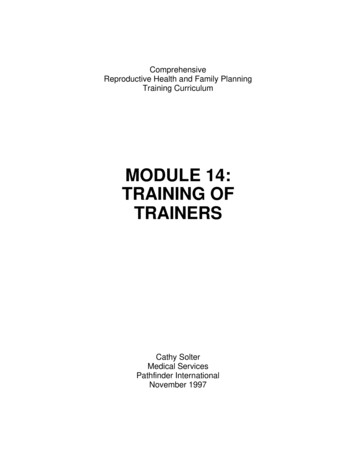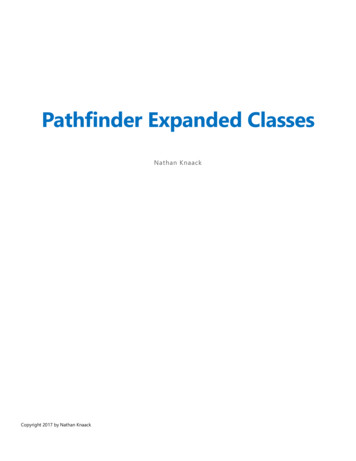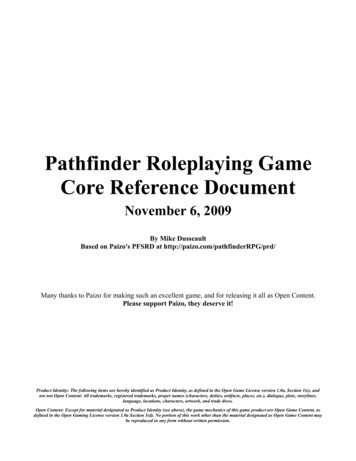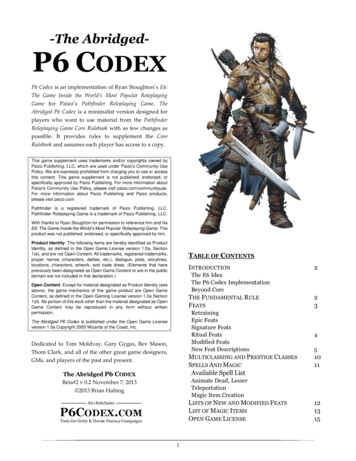
Transcription
-The Abridged-P6 CODEXP6 Codex is an implementation of Ryan Stoughton’s E6:The Game Inside the World’s Most Popular RoleplayingGame for Paizo’s Pathfinder Roleplaying Game. TheAbridged P6 Codex is a minimalist version designed forplayers who want to use material from the PathfinderRoleplaying Game Core Rulebook with as few changes aspossible. It provides rules to supplement the CoreRulebook and assumes each player has access to a copy.This game supplement uses trademarks and/or copyrights owned byPaizo Publishing, LLC, which are used under Paizo's Community UsePolicy. We are expressly prohibited from charging you to use or accessthis content. This game supplement is not published, endorsed, orspecifically approved by Paizo Publishing. For more information aboutPaizo's Community Use Policy, please visit paizo.com/communityuse.For more information about Paizo Publishing and Paizo products,please visit paizo.comPathfinder is a registered trademark of Paizo Publishing, LLC.Pathfinder Roleplaying Game is a trademark of Paizo Publishing, LLC.With thanks to Ryan Stoughton for permission to reference him and hisE6: The Game Inside the World’s Most Popular Roleplaying Game. Thisproduct was not published, endorsed, or specifically approved by him.Product Identity: The following items are hereby identified as ProductIdentity, as defined in the Open Game License version 1.0a, Section1(e), and are not Open Content: All trademarks, registered trademarks,proper names (characters, deities, etc.), dialogue, plots, storylines,locations, characters, artwork, and trade dress. (Elements that havepreviously been designated as Open Game Content or are in the publicdomain are not included in this declaration.)TABLE OF CONTENTSINTRODUCTION2The E6 IdeaThe P6 Codex ImplementationBeyond CoreOpen Content: Except for material designated as Product Identity (seeabove), the game mechanics of this game product are Open GameContent, as defined in the Open Gaming License version 1.0a Section1(d). No portion of this work other than the material designated as OpenGame Content may be reproduced in any form without writtenpermission.THE FUNDAMENTAL RULEFEATSRetrainingEpic FeatsSignature FeatsRitual FeatsModified FeatsNew Feat DescriptionsThe Abridged P6 Codex is published under the Open Game Licenseversion 1.0a Copyright 2000 Wizards of the Coast, Inc.Dedicated to Tom Moldvay, Gary Gygax, Bev Mason,Thom Clark, and all of the other great game designers,GMs, and players of the past and present.MULTICLASSING AND PRESTIGE CLASSESSPELLS AND MAGICAvailable Spell ListThe Abridged P6 CODEX23451011Animate Dead, LesserTeleportationMagic Item CreationBeta#2 v 0.2 November 7, 2013 2013 Brian HabingLISTS OF NEW AND MODIFIED FEATSLIST OF MAGIC ITEMSOPEN GAME LICENSE1121315
your campaign can be daunting. The Abridged P6 Codexsolves this problem by simply excluding almost all ofthe rules beyond the Core. For those wanting a bit more,the unabridged P6 Codex rule set takes a differentapproach – it attempts to select (with modification) therules from the Advanced and Ultimate books that add themost to the feel of the Core game with the leastdisruption. As such, it includes most of the Advancedand Unlimited spells and weapons, many of the feats,versions of selected archetypes (and several new ones),a few of the new rules, and the Magus class. It alsocontains additional rules to make the game moreconsistent over the range of six-levels, includingmodified rules for multi-classing, NPC classes, thecraft/profession skills, and non-combat advancement(so that the best turnip farmer in the world isn’tnecessarily a great fighter too). As always, anypublished combination of rules is strictly optional andeach group should add or discard rules to suit theirtastes. In particular, a group playing The Abridged P6Codex may find that adding a handful of carefullyselected rules from the full P6 Codex gives just the rightamount of customization.INTRODUCTIONTHE E6 IDEAThe Pathfinder system supports a tremendous range ofpower levels, from newly-former apprentices battlinggoblins and kobolds to super-heroes who can teleportbetween planes, stop time, kill with a word, andresurrect a fallen colleague. Not only can a group decideto play anywhere between those extremes, but thestandard setting assumes that every character has thepotential to rise from the lowest ranks to the ultimateheights.E6 is related to the option of having a level cap of lowerthan 20th in the Gamemastering chapter of the CoreRulebook. Instead of simply ending the campaign at 6thlevel, E6 characters advance as normal through 6th leveland then continue to earn feats after that point (in theoriginal E6, one feat was earned for each additional 5,000experience points). An E6 character with many featsbeyond 6th level is certainly more powerful than a 1st, 3rd,or even 5th level character, but they can no longer singlehandedly wade into armies of opponents without fear.However, a huge variety of options are available forimplementing E6 in terms of which feats are availableand how much more powerful the characters canbecome.The main P6 Codex rulebook contains all of the neededrules not found in the Pathfinder Core Rulebook. P6 Codex:Gunsmoke contains the additional rules for adding“emerging firearms” and the Gunslinger class. Finally,the necessary new and adjusted feats for the Alchemist,Antipaladin, Cavalier, Inquisitor, Oracle, Ninja,Samurai, Summoner, and Witch classes are contained inP6 Codex: Apocrypha. While the other P6 Codex books aredesigned to work with just the Pathfinder Core Rulebook,the Apocrypha requires having the appropriate Advancedand/or Ultimate books for the basic information on thoseclasses.THE P6 CODEX IMPLEMENTATIONThere are three guiding ideas behind the post-6th levelfeats available in P6 Codex.The characters should be able to obtain powers similarto a 7th level Pathfinder character by acquiring five ofthese feats.Each single-class character can obtain a signaturepower associated with 8th level (9th in the case ofSorcerers).THE FUNDAMENTAL RULEInspired by the E6 rulesSpells cap off at 3rd level, particularly excludingteleportation spells and returning from death.Upon reaching 6th level, characters cease normaladvancement. Instead, for each 5,000 additionalexperience points beyond 6th level (for fastadvancement; 8,000 for medium, and 12,000 for slow)the character may select a new feat that they meet theprerequisites for. The list of feats available for this “epicadvancement” is expanded to include both epic andsignature feats that are unavailable to characters whoare “merely” 1st to 6th level. These feats are designed soBEYOND COREIn addition to supporting a tremendous range of powerlevels, Pathfinder also presents a staggering number ofoptions in its various non-Core products. Selectingwhich of those rules to use while avoiding gamebreaking combinations and maintaining the flavor of2
that a character can approximate being 7th level after fiveepic advancement feats, and even have the opportunityto earn a power or ability that would typically have beenearned at 8th level (or 9th in the case of sorcerousbloodline powers).be truly epic, the type about whom legends will be spununless they work hard to hush them up.FEATSFeats take on added importance in P6 Codex since theyare central to balanced post-6th level advancement andinsure that some important higher level powers can stillbe utilized. As such, several new feats are added to thosein the Pathfinder Core Rulebook, and several existing featsare modified. The newly added feats include three newtypes: Epic, Signature, and Ritual Feats, as well asseveral other feats to balance out character advancementopportunities. The modifications include limiting thenumber of times certain feats can be taken, making somefeats epic or signature, and altering the Leadership feat.A rule on retraining feats is also implemented.For purposes of encounter balancing and experienceawards, characters with 5 epic advancement feats willgenerally be equivalent to 7th level, and those with 10epic advancements will be roughly equivalent to 8thlevel. Depending on the optimality of the character classchoices, individual feats chosen, and magic itemsacquired these might be beneficially adjusted up ordown for any particular encounter. Beyond ten epicadvancements, additional feats still add to thecharacter’s power, but the characters begin to fall behindin terms of hit points, base attack bonus, saves, availablemagic items, and spells. They will likely neverapproximate the raw combat capability of 9th levelcharacters but may still be able to challenge even morepowerful foes by less brute force means.RETRAININGA character, who wishes to take a new option grantedby a past feat choice (e.g. a new mercy but have alreadytaken the Extra Mercy feat four times, or a differentsignature feat) may drop a previously acquired feat inorder to allow the purchase of a new one throughregular advancement. If the dropped feat was grantedas a class feature then it may only be replaced by anotherfeat that was an option at the time it was obtained. Anyfeat that depended on the dropped feat for a prerequisiteis not lost, but is no longer usable until the prerequisiteis again met.The fundamental rule should have a great impact onworld design – spells for PCs and NPCs stop at 3rd levelexcept for a few rituals, extremely powerful monstersare exceptionally rare if not absent, and magic items arevastly limited. In particular there is almost noteleportation and the only way to return from the graveis as one of the undead. On the other hand, the lack ofsuper-heroic powers gives a logical reason for castlesand armies to still exist. Portions of existing Pathfinderadventures and campaign materials for levels 8 andlower will often be easily usable with P6 Codex, but somemodifications may be needed to their more powerfulNPCs.EPIC FEATSEpic feats may only be purchased during epicadvancement (and not as part of obtaining 6th level).They are typically capabilities that would be obtainableby a 7th level character in Pathfinder.One way of envisioning the character levels is that a 1 stlevel character is roughly equivalent to a journeymancraftsman – a squire just completing their training, aconscripted farmer just off their first tour of duty, or awizard just finishing their apprenticeship. A 3rd levelcharacter is roughly equivalent to a master craftsman –well above the peasants, common laborers, and evencraftsmen in most rural villages, but not uncommon inthe towns and cities. Fifth level would include therenowned master craftsman – one who has achieved arare height for their profession; they would only befound haphazardly in anything smaller than a city andbe few in number for any given profession even in alarger city. Beyond 6th level, a character or NPC wouldSIGNATURE FEATSSignature feats are epic feats that impart a capabilityobtainable for an 8th level character in Pathfinder (or 9th inthe case of sorcerous bloodline powers). Each charactermay take one signature feat. An additional signaturefeat may be taken for every ten epic advancementsearned.3
RITUAL FEATSmaking the ritual generally useless) then the total levelneeded is doubled. Unless otherwise indicated in thefeat description, when the ritual begins the requiredspells are lost and take no effect (except for fulfilling therequirement for the ritual).Inspired by the E6 Restoration and Stone to Flesh FeatsRitual feats allow members of the primary spell-castingclasses (Cleric, Druid, Sorcerer, or Wizard) to cast a spellthat is higher than 3rd level for their class. Clerics,Druids, and Wizards may learn any number of rituals.Sorcerers may learn two rituals, plus one additionalritual if their Charisma is 18 or higher. P6 Codex includesthe ritual feats for Animate Dead, Atonement, BreakEnchantment, Dismissal, Hallow, Neutralize Poison,Remove Curse, Restoration, and Stone to Flesh bydefault.Casting time: The casting time in the ritual featdescription already includes the casting andexpenditure of all required spells. The casting time forthe ritual is typically one hour for spells that areordinarily cast in one round or less.Components: All components of the spell the feat isnamed for are utilized as per the spell description.Components are not required for any expended spells.If the feat requires casting of a spell then that requiredspell’s components are also needed.Prerequisites: In cases where the spell is 3rd level orlower for some other primary spell-casting class, theritual feat’s prerequisites are the ability to cast 3rd levelspells, having the requisite ability of 10 spell level fortheir class, and to have 5 ranks in a specified skill. If thespell is 4th level or higher for all classes then it is an epicfeat and requires having 6 levels in the relevant classinstead of 5, and having 6 ranks in the relevant skillinstead of 5. A campaign that allowed additional ritualfeats may want to classify some (e.g. Create Undead,Plane Shift, Raise Dead) as signature instead of epic andrequire the Epic Caster feat and a 7 in the relevant skill(which can be gained by the Extra Skillfulness capacityfeat; both feats are described below).Range: The range of the ritual is the range of the spellthe ritual is named for. Unless otherwise indicated, thetarget must be within range for the entire casting time.Ritual spells may not be used in the creation of magicitems.Concentration: The level of the spell the ritual is namedfor counts as the spell level for the purpose ofconcentration checks.MODIFIED FEATSEleven feats from the Core Rulebook are modified for P6Codex:Expenditure of spells: Use of a ritual feat requires theexpenditure or casting of a closely related specific spell,and the expenditure of additional spell levels of a certainschool. Clerics, Druids, and Wizards must either havethe specified spell and spells of the required schoolprepared before beginning the ritual or be able tospontaneou
advancement (and not as part of obtaining 6th level). They are typically capabilities that would be obtainable by a 7th level character in Pathfinder. SIGNATURE FEATS Signature feats are epic feats that impart a capability obtainable for an 8th level character in Pathfinder (or 9th in the case of sorcerous bloodline powers). Each characterFile Size: 766KBPage Count: 15
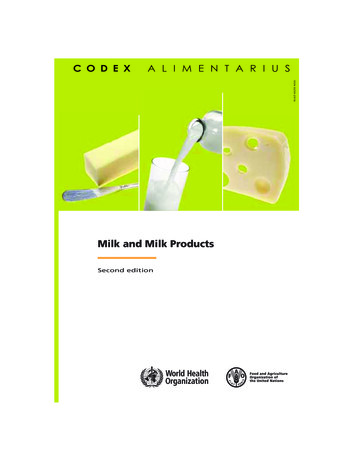
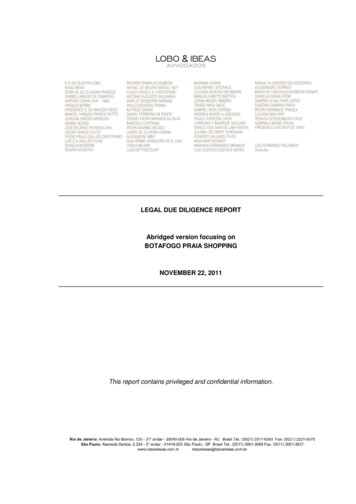
![Letter from Birmingham Jail (1963) [Abridged]](/img/2/1963-mlk-letter-abridged.jpg)
